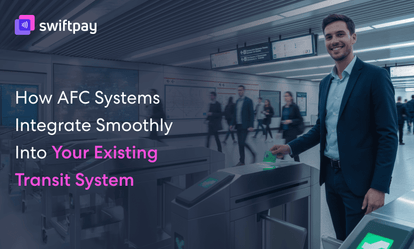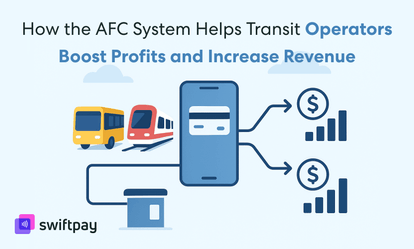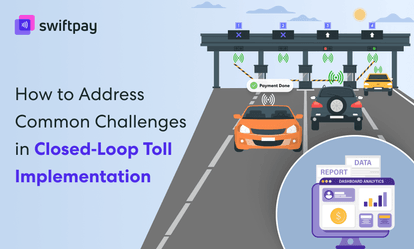Public transportation is often referred to as the ‘lifeline’ of cities. But let’s be honest, it��’s not always the first choice.
The rise of ride-sharing apps, car ownership, and expectations for convenience have put transit systems under pressure to stay relevant and competitive.
Transit operators like you can optimize routes, upgrade infrastructure, and modernize vehicles, but if people don’t keep coming back, it’s hard to sustain impact.
So, what can be done then?
Well, you have to offer something that attracts people. And not just that, but it should also be compelling so people get hooked on it.
Loyalty strategies can help a lot in achieving that. And that’s exactly what this blog is all about.
Here’s what we’ll cover in this blog:
- Why loyalty in public transport deserves more attention (and loyalty lesson from other industries)
- The psychology behind rider loyalty, and how habits are formed
- Proven loyalty strategies for transit systems
- How payment experience directly impacts rider satisfaction and retention
- The role of closed-loop auto fare collection in enabling smarter & personalized loyalty
- Real-world examples of successful public transport loyalty and reward program
- Why now is the time for transit operators to rethink how they reward their riders
Let’s get started.
Why loyalty in public transport deserves more attention
The simple answer is that other industries have already proven it works.
Airlines, coffee chains, and retail brands figured this out long ago: loyalty isn’t just about discounts. It’s about reinforcing behavior.
Frequent-flyer programs reward consistency. QSR apps reward repeat visits. Retailers use points, perks, and early access to keep buyers engaged.
It’s transactional, but it’s also emotional.
The same logic can be applied to improve the overall public transit experience. It’s not a ‘loyalty program’ in the traditional sense, but what you’re really building is rider commitment.
Unique challenges in public transportation
Loyalty in transit is a bit different. Commuters aren’t choosing between a latte and a sandwich. They’re weighing time, cost, safety, and convenience. And they usually have to make quick decisions.
Besides, throw in rising competition from ride-hailing and shared mobility, and you’ve got a challenge that can't be solved by convenience alone.
That’s why loyalty matters more in the case of public transportation and it also play a significant role in overall passenger experience.
The psychology behind loyalty
If you are figuring out your loyalty strategies, then it helps to know the psychology behind it.
Behavioral science tells us people form habits through repetition and reward.
Hence, if you reinforce a choice often enough and make that reward feel personal, you increase the chances of it sticking.
Loyalty in public transport isn’t just about saving money. It’s about:
- Building routines
- Offering recognition
- Making riders feel that every trip counts
Types of loyalty strategies that work for public transport
Different transit systems have different goals, but it safe to say that all can benefit from smart and intentional loyalty mechanics.
Let’s see different types of loyalty strategies that can be put into practice:

Ride-based rewards or cashback
Simple ideas work best. And the ideal behind cashbacks or ride-based rewards is simple: You offer a free ride after a number of rides. You can decide the number based on the number of passengers and service frequency.
Other than that, you can give off-peak riders a small discount. Plus, reward consistent weekly travel.
Not only does this increase usage, it also helps shift demand away from peak congestion, which makes your service more efficient overall.
Subscription passes and fare caps
Flat-rate passes or daily/weekly fare caps take the guesswork out of transit spending. This makes public transport easier to commit to.
It’s loyalty in disguise: when someone knows what they’ll pay, they’re more likely to make transit part of their routine.
Referral or group commute incentives
Riders bring more riders. Referral bonuses or group commute perks are ideal for targeting colleges, workplaces, and residential clusters.
This is among the most effective ways to grow your network organically. And loyalty spreads by word of mouth.
Closed-loop e-wallets or cards with built-in rewards
Now we’re getting to the good part.
Closed-loop payment systems for mass transit let you issue branded cards or closed loop e-wallet apps that are used only within your transit ecosystem.
Funds can be preloaded or you can allow you customers to do that as well. You can also add bonuses for recharges, or push targeted offers based on rider behavior.
Basically, you control the system and the payment experience.
Gamification to engage riders
Sometimes, a little fun goes a long way. Gamifying your auto fare collection is the best way to do it.
Reward eco-friendly trips, build challenges around ride frequency, or introduce digital badges for milestones.
Gamification may not appeal to everyone, but for digitally savvy riders will be tempted. It adds energy and a bit of purpose to the daily commute.
What does loyalty systems look like in public trasnit?
Loyalty in public transport isn’t a theoretical concept; it’s already happening in many cities across the world.
Below examples show how different transit operators like you are using rewards, personalization, and partnerships to turn riders into repeat travelers:
Club Eurostar (UK and Europe)
Eurostar’s loyalty program makes every journey count. Riders earn points each time they travel, which can be redeemed for perks like free tickets, upgrades, or exclusive discounts.
It’s tiered as well. So, as members move up the ladder, they unlock even better benefits like hotel and car rental offers through partners such as Hertz and American Express.
Hence, it’s more than just a train ride for customers. It’s an ecosystem of value.
Más Renfe (Spain)
Spain’s national rail operator has built a loyalty program that feels like a frequent flyer model for trains. Members earn points not only on Renfe bookings but also through brand partnerships.
There are multiple tiers—from silver to platinum—and each level comes with extras: annual discounts, free upgrades, and more. It keeps travelers moving forward, not just physically, but emotionally invested in the system.
BahnBonus by Deutsche Bahn (Germany)
Deutsche Bahn’s BahnBonus focuses on business travelers. It rewards them for consistent travel across Germany’s rail network.
What’s unique about it is that points can also be donated to support environmental causes or local charities. Riders can choose between personal rewards or doing something bigger with their miles. That’s loyalty with purpose.
STM Merci (Montreal, Canada)
Montreal’s STM launched Merci, a mobile-first loyalty program that feels refreshingly human.
Users receive personalized offers, two-for-one ride deals, and targeted nudges based on their habits.
One of its standout features is that it re-engages lapsed riders—people who’ve stopped riding regularly—with timely offers to bring them back on board. And yes, it’s been shown to boost ridership.
The connection between payment experience and loyalty
Well, when you are considering loyalty strategies for public transit, you should know why seamless payments matter.
Because no one remembers a great payment experience. Yes, good things are usually taken for granted.
But everyone remembers a bad one. A broken reader. A long queue. An app that won’t load.
Friction at the fare gate leaves a mark. It slowly erodes passenger experience.
But when payments are fast, intuitive, and invisible? That helps build trust. That’s when riders don’t just show up, they keep coming back.
Auto fare collection makes it possible
Automated fare collection (AFC) systems streamline the entire fare collection process. It allows your customers to tap and go.
And operators like you get real-time data. And best of all, the system runs in the background, which creates less hassle for everyone.
Now, blend AFC with closed-loop payments, that’s how you can provide built-in loyalty features to your customers.
Why closed-loop AFC is ideal for building transit loyalty
Closed-loop AFC systems take all the benefits of automation, and give you full ownership.
Unlike open-loop systems that rely on banks and third-party platforms, closed-loop systems let you control what kind of incentives you want to provide and the data.
That’s a strategic advantage in any market. Let’s explore why it’s ideal for building loyalty:

Enables targeted incentives and rewards
With closed-loop prepaid cards or e-wallets, you can reward your top users, incentivize recharges, or introduce tiered benefits.
Want to reward college students with discounted fares? You can do that. Want to offer bonus rides after a certain spend? Also doable.
It’s flexible and effective.
Encourages frequent usage through stored value
When someone loads $50 into your transit wallet, they’ve already committed. That preloaded value sits as a psychological nudge, which makes it more likely they’ll use your service again.
It’s the transit version of “sunk cost bias” in a good way.
Offers richer insights for smarter engagement
With full control over the payment system, you get direct access to rider data like:
- Travel patterns
- Recharge behavior
- Lapsed users
That data helps you segment your riders and send personalized nudges or offers. You don’t need any third-party tools.
Offline capabilities
Closed-loop prepaid cards and e-wallets can be configured to work even when the network is down or limited.
For your passengers, it’s convenience without interruption. For you, it’s peace of mind that loyalty won’t be paused due to connectivity issues.
Read more - How Auto Fare Collection Systems Boost Public Transit Usage
Final words
Loyalty is about handing out rewards in a way that becomes habits.
To do it right, you have seen various loyalty strategies and how they can help transit operators like you grow ridership, balance demand, and increase satisfaction.
It all starts with making every interaction just a little easier, a little smarter, and a little more rewarding.
Closed-loop AFC systems give you the tools to make that happen. With full control over how people pay and how they get rewarded, you’re no longer just collecting fares, you’re building lasting relationships.
If you're looking to grow ridership and make every journey count, SwiftPay can help you turn occasional users into loyal riders.
Let’s make public transport feel like the obvious choice rather than the last resort.




